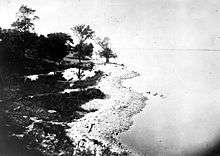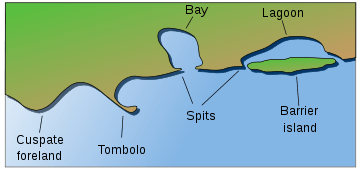Beach ridge



A beach ridge is a wave-swept or wave-deposited ridge running parallel to a shoreline. It is commonly composed of sand as well as sediment worked from underlying beach material. The movement of sediment by wave action is called littoral transport. Movement of material parallel to the shoreline is called longshore transport. Movement perpendicular to the shore is called on-offshore transport. A beach ridge may be capped by, or associated with, sand dunes. The height of a beach ridge is affected by wave size and energy.
A fall in water level (or an uplift of land) can isolate a beach ridge from the body of water that created it. Isolated beach ridges may be found along dry lakes in the western United States and inland of the Great Lakes of North America, where they formed at the end of the last ice age when lake levels were much higher due to glacial melting and obstructed outflow caused by glacial ice. Some isolated beach ridges are found in parts of Scandinavia, where glacial melting relieved pressure on land masses and resulted in subsequent crustal lifting or post-glacial rebound. A rise in water level can submerge beach ridges created at an earlier stage, causing them to erode and become less distinct. Beach ridges can become routes for roads and trails.
See also
Sources
- Water Resource Availability in the Maumee River Basin, Indiana, Water Resource Assessment 96-5, Indianapolis:Indiana Department of Natural Resources, Division of Water, 1996, p. 191. May be found in pdf format at (This document is in the public domain.)
- Forsyth, Jane L., The Beach Ridges of Northern Ohio, Columbus: Ohio Division of Geological Survey Information Circular 25, 1959, 10 pages (out of print).
- Great Lakes Information Network: Great Lakes Shoreline Geology

